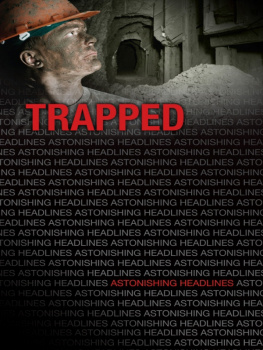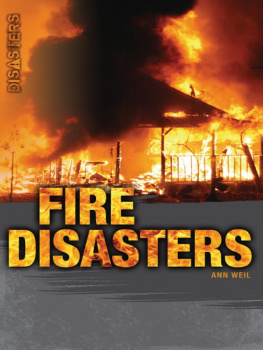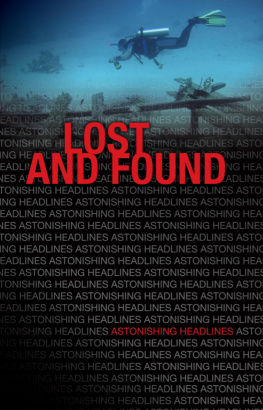

TRAPPED
Glenn Cheney

ASTONISHING HEADLINES
| Attacked | Missing |
| Captured | Shot Down |
| Condemned | Stowed Away |
| Kidnapped | Stranded at Sea |
| Lost and Found | Trapped |

Copyright 2005, 2013 by Saddleback Educational Publishing
All rights reserved. No part of this book may be reproduced in any form or by any means, electronic or mechanical, including photocopying, recording, scanning, or by any information storage and retrieval system, without the written permission of the publisher. SADDLEBACK EDUCATIONAL PUBLISHING and any associated logos are trademarks and/or registered trademarks of Saddleback Educational Publishing.
ISBN-13: 978-1-61651-927-8
ISBN-10: 1-61651-927-4
eBook: 978-1-61247-084-9
Printed in Guangzhou, China
0000/CA00000000
17 16 15 14 13 1 2 3 4 5
Photo Credits: Cover, Reuters Photo Archive; , AFP / AFP / Getty Images
CONTENTS
What could be more terrifying than being trapped? You think there is no escape. There may be no time for rescue. Your whole life is replayed in your mind. You are trapped, and it looks as if there is no way out. Stay calm. Do not lose control. Use your wits. Maybe help is on the way.
Think of all the ways that people can be trapped. A fire can trap them in a building. The sea can trap them in a submarine. A flood can trap them on high ground. After an earthquake, people may be trapped under building rubble. Sometimes, governments trap their people behind walls, both real and imagined.
Watch Out for Traps
What is the best way to stay out of a trap? Think ahead. See the trap before it traps you.
In a movie theater, plane, or hotel, look for the emergency exits.
On a ship, look for lifeboats and life preservers.
In a car or school bus, know how to unlock the door or use the emergency exit.
At home, think of all the ways you can get out if there is a fire.
Do not put a hand or foot into a big machine or farm equipment.
If someone else is trapped, dial 9-1-1 on any telephone. If you are trapped, do not panicthink. Let your brain be your friend, not your enemy.
DATAFILE
Timeline
May 1908
The first skyscraper, the Singer Building, is built in New York City.
March 1911
A fire at the Triangle Shirtwaist factory in New York kills 146.
Where is New York City?

Key Terms
fire escape stairs outside a building that give people a way to escape a fire
inspector a person who is hired to check for problems
sweatshop a hot, crowded, unsafe shop or factory in which employees work long hours at low wages
Did You Know?
There are many laws that help prevent fires. Other laws also make it easier to escape from buildings if they catch fire.
CHAPTER 1
The Triangle Shirtwaist Fire
On March 25, 1911, a deadly fire in a New York factory killed 146 people.
The Triangle Shirtwaist Company made shirts. A shirtwaist was a blouse for women. The fabric was light and silky. But it burned easily.
The Triangle Shirtwaist factory was a 10-story building in New York City. Hundreds of people worked there. They cut cloth, sewed shirts, and packed boxes.
Sweatshops
It was not a nice place to work. The pay was very low. The work was hard. The rooms were hot and crowded. Employees worked seven days a week.
Almost all of the workers were women and children. The company hired children because they worked for less money. Some children were only 11 years old. Factories like these are called sweatshops.
Worst of all, the bosses kept most of the windows and the doors locked. The workers could not go outside until it was time to quit. They were locked in!
Children Hid
The law said that children could not work in a factory. Sometimes inspectors came to look for children. The children hid under piles of shirts. No one saw them.
No one liked working in the factory. But in those days, it was hard to find a job. Without a job, people could not buy food or pay rent. When a worker found a job, he or she stayed with it.
Fire!
The fire started on the eighth floor of the factory. No one knows how it started. The floor was covered in paper and cloth scraps.
The fire spread quickly. It spread to the ninth floor. Cloth was everywhereon the floor, on tables, and hanging from racks. It was a perfect place for a fire.
There were no fire extinguishers in the factory. All the workers had were 27 buckets of water, but that was not enough. They had a hose, but it did not work. It had holes in it.
A Stampede
Everyone panicked. Screams filled the rooms. The women and children tried to go out to the fire escape. But the door was locked.
They stampeded to the stairs. The door to the stairs pulled into the room. It was not one that pushed out. In their panic, they pushed against the door. They could not pull it open.
The flames spread and grew hotter. Wooden floors and tables caught on fire. Peoples clothes caught on fire. They could not get away.
Smoke filled the room. Everyone coughed and struggled to breathe. Many people broke the windows. Then they jumped out!
More than 60 people died as they jumped from the firetrap.
The fire department was slow to arrive. When they got there, the fire hoses could shoot water only to the seventh floor. The ladders reached only to the sixth and seventh floors.
Brave People Help
A brave elevator operator kept going back to the eighth floor. The elevator was built to hold 10 or 15 people. More than 30 crammed in.
Risking his life, the elevator operator returned again and again. He saved more than 100 people.
People in a tall building next door lowered ladders to the roof of the Triangle building. More than 100 people escaped this way.
But 146 people, including those who jumped, did not escape death.
New Laws
To prevent more disasters, the government passed new laws. Factory and office doors could not be locked. They had to open out, not in, so people could push them open. Floors had to be clean. Every room needed two exits and a fire extinguisher.
It was a hard way to learn a lesson. Today, workplaces are safer, and children do not work in factories in America.

Firefighters battle the flames at the Triangle Shirtwaist factory.
DATAFILE
Timeline
September 1918
The Boston Red Sox win the World Series of Baseball.
January 1919
A tank of molasses ruptures in Boston, killing 21.
Where is Boston, Massachusetts?

Key Terms
elevated train
Next page















